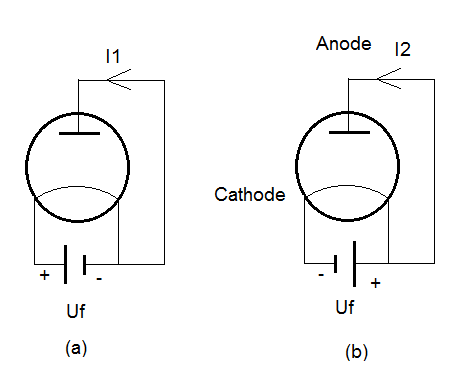Thermoelectronic emission
The vacuum diodes (they were used back in the ’60 years in electronics) have direct heating cathodes. This means that a DC voltage source is applied between both ends of each cathode to heat it electrically. Both diodes present identical ideal characteristics (the characteristics are similar those of our days ideal diodes). Both DC voltages used to heat the cathodes are identical, but they are wired differently in the circuit (see the figure). Are there differences between the intensities of anode currents $I1$ and $I2$ in the two circuits?

Although the two circuits are identical, having the same DC voltage source for cathode heating, and the same external polarization (the voltage between the anode and cathode is null, $E_A =0$), the intensities of the currents $I1$ and $I2$ are not the same. This is due to the fact the vacuum diode
cathodes have two ends. It is a bit like having two semiconductor diodes sharing the same anode but with two different cathodes.
In the first case (a) the voltage between the anode and the end of the cathode wired to the negative potential of the DC heating source ($U_f$)is null, and the voltage between the anode and the other end of the cathode is negative ($U_A =-U_f$). Thus no electron emitted by the heated cathode will arrive at the anode and the anode current will be zero. $I1$ =0.
In the second case (b) the voltage between the anode and the end of the cathode wired to the positive potential of the DC heating source ($U_f$) is null, and the voltage between the anode and the other end of the cathode is positive ($U_A =+U_f$). Thus the electrons emitted by thermal emission
from the second cathode (b) will arrive at the diode anode (which has a positive potential) and the current in this case will be nonzero. $I2>0$
This is valid of course only for vacuum diodes having direct heating cathodes, where the heating DC potential is directly applied to the cathode. There are “modern” vacuum diodes where the filament that heats the cathode is electrically insulated from the cathode itself, and the above discussion fails for this case.
